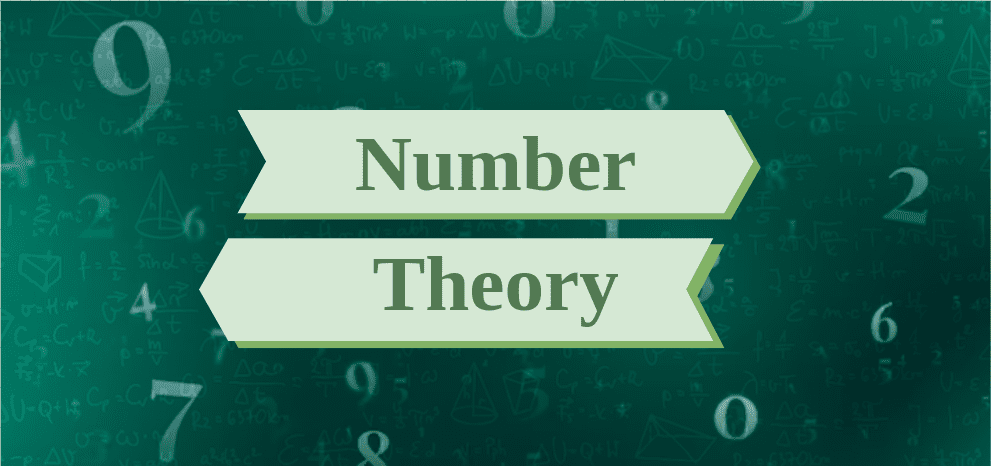Real-Life Applications of Number Theory
Last Updated :
09 Apr, 2024
Number theory, one of the branches of mathematics that examines the nature of numbers, has a huge influence on various practical applications in the real world. Number theory is the mother of all those branches of mathematics that are used in the development of algorithms and solutions for complex problems in the fields of cryptography, computer science, business, and telecommunication.
This article tackles the use cases of number theory in different disciplines, recognizing its role in the evolution of modern technology.

Number Theory
Number theory is a branch of pure mathematics devoted primarily to the study of the integers and integer-valued functions. It deals with the properties and relationships of numbers, especially the properties of the natural numbers, or positive whole numbers.
It’s not just about adding or subtracting; it’s about discovering the hidden rules that numbers follow, like why some numbers can only be divided by 1 and themselves (we call these prime numbers), or figuring out puzzles and patterns that numbers form. It’s all about exploring the mystery and magic behind the numbers we use every day.
Read More about Number Theory.
Real-Life Applications of Number Theory
Some of the common fields where number theory is used are:
- Cryptography
- Data Security
- Computer Science and Algorithms
- Coding Theory and Error Correction
- Computer Graphics
- Financial Mathematics and Cryptocurrency
Let’s discuss the applications in detail.
Applications of Number Theory in Cryptography
Modern cryptographic algorithms for data and communications security are based on number theory, the basic concepts of which govern the field. Concepts such as prime numbers, modular arithmetic, and discrete logarithms are the ones underlying billions of cryptographic encryption and decryption methods.
- Example: The RSA algorithm (Rivest-Shamir-Adleman), commonly used in data encryption systems, involves the theory of numbers. It is through the employment of prime numbers that public as well as private keys that are used for encryption and decryption of messages are generated.
Applications of Number Theory in Data Security
In these number theory-based encryption methods, the data in digital transactions, online banking, and e-commerce is kept highly secure. We create a safe space for personal information by using these methods to prevent unauthorized access and data dumps.
- Example: The Diffie-Hellman key exchange protocol exploits the concepts of number theory, such as modular arithmetic, to allow peers to establish secure communication channels and exchange ciphertexts securely.
Applications of Number Theory in Computer Science and Algorithms
Integral algorithms of number theory are applied in different computer science branches, e.g., data structures, sorting algorithms, and optimization techniques. They optimize the computer power and speed of algorithmic implementations.
- Example: The Euclidean algorithm for solving the greatest common divisor (GCD) of two numbers is a well-known numerology algorithm applied in computer science. It is necessary for exercises such as getting rid of fractions and making mathematical calculations easier.
Applications of Number Theory in Coding Theory and Error Correction
Number theory is closely related to coding, where most of the coding methods are based on mathematical properties. Such algorithms allow error detection, correction, and recovery in machine-based communicative nodes and data storage facilities.
- Example: The Reed-Solomon error correction code is a variation used in digital storage devices such as CDs, DVDs, and QR codes, and it is based on number theories. It helps in the reconstruction and recovery of the lost packets; even if there is an error, it can still be corrected.
Applications of Number Theory in Computer Graphics
Numerical theory concepts are utilized by some computer graphics algorithms in order to make shuffles, minimize operations, and detect flaws during the graphics element, simulation, and visual effects generation.
- Example: The computer graphic that was probabilistically created by the Miller-Rabin primality test, a number theory-based algorithm, is used in generating random numbers. It contributes to good graphics quality (more visual effects and simulations) in the rendering of visual effects.
Applications of Number Theory in Financial Mathematics and Cryptocurrency
Number theory is making a great contribution to financial mathematics in modeling financial markets, risk management, and the determination of derivative pricing. Moreover, it lies on the foundation with a promise of blockchain technology in the cryptocurrency network like Bitcoin as well.
- Example: The Elliptic Curve Digital Signature Algorithm (ECDSA), which is based on the number theory of elliptic curves, is the cryptographic algorithm used for crypto currency transactions secured and the signature being verified digitally.
Conclusion
Number Theory is something that serves as the basis for all difficult mathematical problems and applications in multiple fields, from technology to security, finance, and communications, among others, all of which result in development. The knowledge of the practical usage of the number theory for building systems and technologies that can be applied in all areas of life subjects to further developing the number theory ideas and seeking new ways to use it.
Related Articles
FAQs on Real-Life Applications of Number Theory
What is Number Theory?
Number theory is a branch of mathematics that deals with the properties and relationships of numbers, particularly integers.
What are Prime Numbers?
Prime numbers are natural numbers greater than 1 that have only two positive divisors: 1 and themselves. Examples include 2, 3, 5, 7, 11, and so on.
What is the Fundamental Theorem of Arithmetic?
The Fundamental Theorem of Arithmetic states that every integer greater than 1 can be expressed uniquely as a product of prime numbers, up to the order of the factors.
What is the Goldbach Conjecture?
The Goldbach Conjecture, proposed by Christian Goldbach in 1742, suggests that every even integer greater than 2 can be expressed as the sum of two prime numbers.
What is Modular Arithmetic?
Modular arithmetic is a branch of number theory that deals with operations on congruence classes or residue classes.
Share your thoughts in the comments
Please Login to comment...